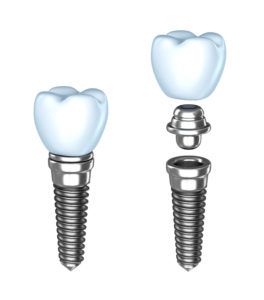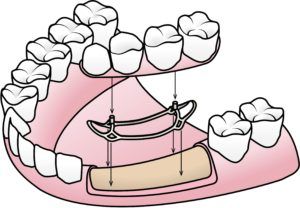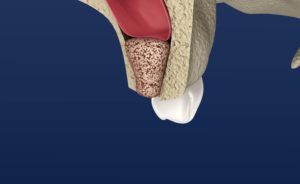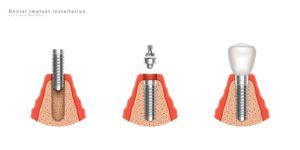Dental Implants
Dental implants are a common dental restoration used to restore damaged, decayed, or missing teeth. There are two different types of dental implants: subperiosteal and endosteal. Subperiosteal implants sit on top of the jawbone below the gum line. Because they are not implanted into the jawbone, they lack the strength of endosteal implants and are not often used.


Endosteal implants, on the other hand, are composted of titanium screws that are implanted into the jawbone. Once healed, endosteal implants fuse with the surrounding bone and act as artificial tooth roots that can support a dental prosthesis. When most dentists refer to “dental implants” they are usually referring to endosteal implants, or traditional dental implants. Endosteal implants are able to offer strength, increased aesthetics, and restored tooth function.
Once placed, dental implants can support a dental prosthesis such as a dental crown, bridge, or implant supported dentures. Dental crowns are generally used to restore single teeth, while a dental bridge can restore multiple teeth. In cases where large amounts of teeth or a full arch needs to be restored, implant supported dentures may be placed.
Did You Know?
A traditional dental implant is composed of three different pieces. The implant screw is the first piece that is embedded into the jawbone and acts as an anchor. The next piece is the abutment, or connector, which screws into the implant and allows for the mounting of a dental prosthesis, which is the final piece.
Frequently Asked Questions:
Am I a candidate for dental implants?
You may be a candidate for dental implants if you have teeth that are severely decayed or damaged. Additionally, you may also be a candidate for dental implants if you have missing teeth or teeth that need to be extracted due to damage or decay.
Ideal candidates for dental implants also have adequate bone mass surrounding the proposed implant area. If your teeth have been missing for longer than six months, you may or may not have enough bone mass for dental implants. However, this doesn’t necessarily mean that you cannot have dental implants. Only a consultation with Dr. Claudia Wood of Danforth Dental can determine your eligibility. To determine if dental implants are an ideal dental treatment choice for you, schedule a consultation today!
What if I am lacking adequate bone mass?
As mentioned before, if you are lacking bone mass it doesn’t necessarily mean that you cannot have dental implants. Depending on your individual situation, Dr. Wood may recommend one of the following treatments to replenish lost bone mass.
Bone Graft:
A bone graft works to increase the bone mass of a certain area by placing bone material at the desired area. This bone material can be harvested from your own body or can be artificially produced in a lab. Once implanted, the bone material will eventually grow into new, healthy bone in about 3-6 months. In some cases, bone grafts are completed before implant placement and in other cases, a bone graft can be completed at the same time as implant placement.

Sinus Lift:
A sinus lift is a specialized bone graft that is performed on the top of the mouth (maxilla). Because your sinus cavity sits just above your upper jaw, the purpose of a sinus lift is to add bone between your teeth and your sinus cavity to ensure that the implant cannot damage the sinus cavity. Just like a bone graft, bone material is added to the area and left to grow into new bone.
Ridge expansion:
Ridge expansions are not as common as bone grafts or sinus lifts, but they offer a solution for those who have extremely small or narrow mouths that do not have enough room to accommodate a dental implant. During a ridge expansion, bone material is placed at an incision in the top of the mouth to cause bone to grow and widen the palate.
What can I expect when having dental implants placed?
The dental implant placement process is usually completed with multiple appointments. A consultation is usually the first step of the process. During your initial consultation, Dr. Wood will perform an examination of your teeth, gums, and bite. She may also take dental x-rays to determine how much bone mass you have. Using this information, she will design a treatment plan for your individual case.
If you choose to move forward with treatment, you will return on a different day to have your implants placed. The implant placement procedure is a minor oral surgery, so you will be anesthetized and sedated to keep you comfortable and relaxed.
The implant procedure begins with a small incision being made in the gums to access the jawbone. Then a series of drills will be used to drill and shape a hole in the jaw bone for the implant. Finally, the implant screw will be screwed into place and the gums will be sutured shut over it.
In some cases, the abutment may be connected to the implant screw. If this is the case, the abutment will protrude above the gum line and the gums will be sutured around it. In other cases, such as with immediate load or teeth in a day implants, a temporary dental prosthetic will also be attached.

With the exception of immediate load implants, most dental implants require a healing period of about 3-6 months before the abutment and/or dental prosthesis can be attached. During this healing period, a process called osseointegration occurs. Osseointegration is the fusing of the implant screw to the surrounding bone and is a necessary part of implant success.
Once the bone has fused with the implant, another procedure will be performed to place the abutment and a temporary dental prosthesis. A dental impression or digital scan will then be taken of the mouth and sent to a dental laboratory for the fabrication of the final dental prosthesis. Once the permanent restoration has been fabricated, it will be placed in the mouth, checked for color and fit, and permanently cemented. This completes the implant process.
What can I expect after undergoing dental implant placement?
After undergoing dental implant placement, you may experience some soreness. Usually any discomfort can be remedied with over the counter pain medications and ice. In the first 48 hours following your procedure, it is recommended to use ice for 15 minutes on and 15 minutes off. After 48 hours, heat can be used for 20 minutes on and 20 minutes off.
You will also need to temporarily modify your diet until your implant heals. In the days following your procedure, you will want to stick to cool, soft foods. As you start to recover, Dr. Wood will discuss what types of foods you can eat without causing damage to your implant.
Finally, you will need to keep the treatment site clean and free of debris. After your procedure, you will be provided with specific directions on how to do this. For the best results, it is important that you follow these instructions as well as those pertaining to pain management and diet.
For dedicated and caring dental care, schedule a consultation with Dr. Claudia Wood of Danforth Dental Solutions. Danforth Dental Solutions is proud to serve Toronto and the surrounding areas.






